You’ve selected your buying signals and you’re running signal-based sales plays, but you’re hitting a ceiling in terms of results.
How do you kick your signal-based selling up a notch? That’s right—signal stacking.
Read on to learn how to stack buying signals (or check out the recording above to watch me break it down in real time).
What is signal-based go-to-market?At Common Room, we define signal-based go-to-market as capturing buying signals across trackable digital touchpoints to identify people and accounts that are in-market and using the context from those signals to take action. In other words, using buyers’ actions and attributes to reach the right person with the right message at the right time.
Maximize the value of signal categories
Before we dive deep into signal stacking (aka merging different types of buying signals together), you should make sure your existing signal-based plays are really hitting diminishing returns and aren’t just in need of some recalibrating.
I recommend categorizing signals based on type (think things like product signals, website signals, and social signals—I put together a handy resource to show you what I mean here) and fine-tuning each category before mixing and matching different types of signals.

The reason is twofold:
1. Scalability
Grouping similar signals together (like all signals related to product usage, for example) makes it easier to scale outreach.
For instance, there are numerous types of product-based signals. To name a few:
- New account/free trial sign-up
- Integration connected
- Multiple workspaces created
- Spike in product usage
- Drop in product usage
- Trial end/paid ceiling threshold reached
While they’re all different, they all call for similar messaging patterns.
In this case, that means something along the lines of, “I see you’re doing X in the product, I can infer Y based on your activity, let’s talk about how Z can help.”
Your outreach should always be personalized and relevant based on the specific account and prospect, but there will be overlap you can use to create prebuilt messaging in advance.

2. Optimization
Combining signals into categories makes it easier to ensure you’re optimizing your approach to different plays.
This is especially important for plays built around high-volume signals. You want to make sure you’re maximizing the value of your top signals.
We’ll stick with product-based signals as an example.
Say you initially saw good results from product-based sales plays, but now you’re experiencing a slump. This could mean any number of things.
Maybe speed to lead has slowed down and it’s hurting conversion rates. Maybe your onboarding messaging needs to be more clear. Or maybe you simply need to add more (or different) touches to your outreach sequence.
Just because you see positive results from a signal-based play doesn't mean it’s one and done. There’s usually more you can do to move ROI up and to the right.
And here’s a bonus: Once you’ve categorized all the buying signals at your disposal, it’s that much easier to start stacking them.
Once you start seeing diminishing returns and run out of obvious optimization opportunities, it’s time to explore signal stacking.
Stack signals to prioritize and personalize
It’s smart strategy to optimize different signal categories, but you’re bound to hit a limit on what’s possible with one type of signal eventually.
This is where signal stacking comes in.
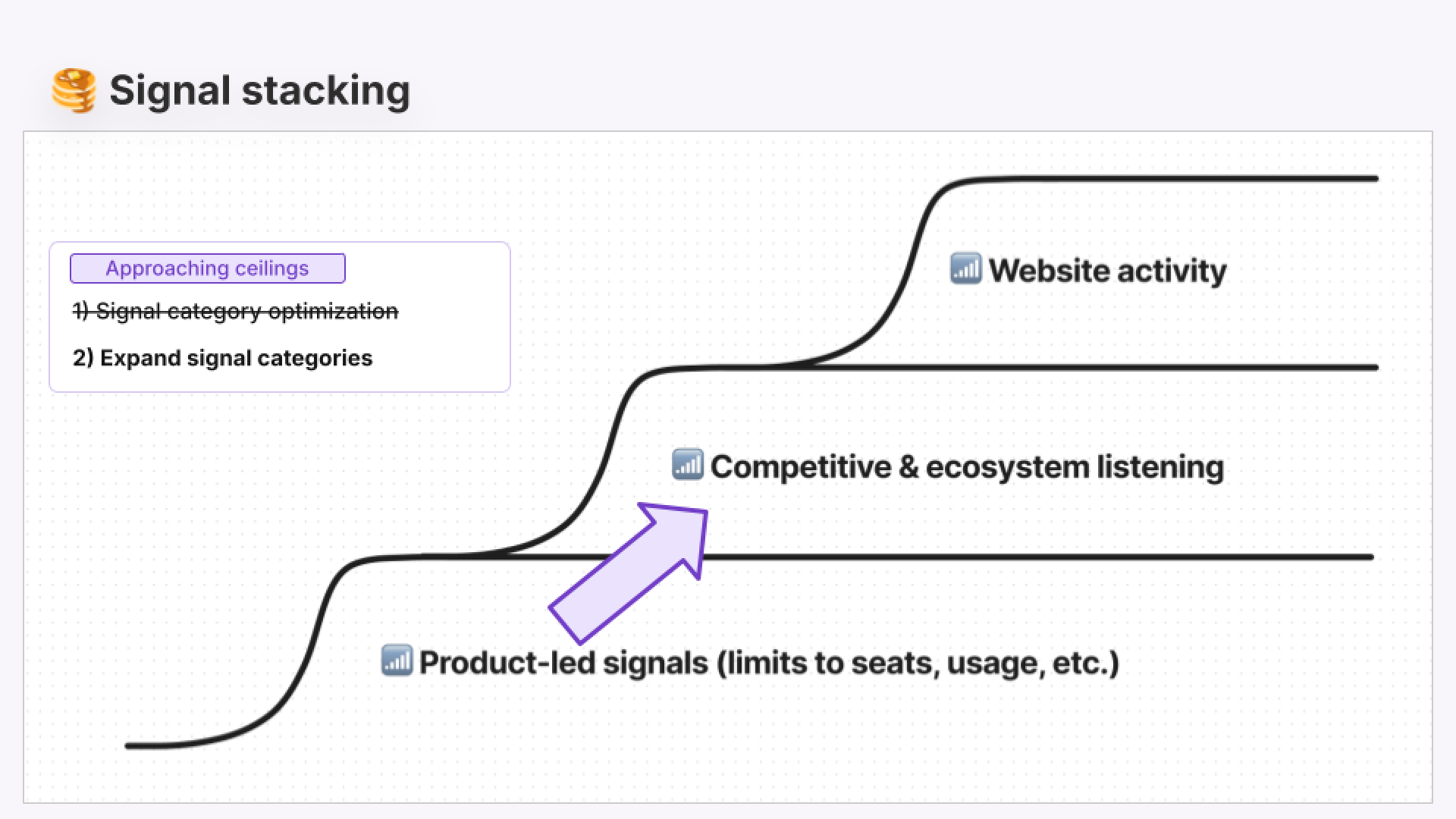
When you boil it down, signal stacking helps you do two things:
1. It helps you prioritize prospects (a buyer who checks multiple intent or in-market boxes is naturally more appealing).
2. It helps you personalize outreach (the more context you have to craft a message, the more that message is going to resonate with buyers).
Let’s walk through some examples of what signal stacking looks like in practice.
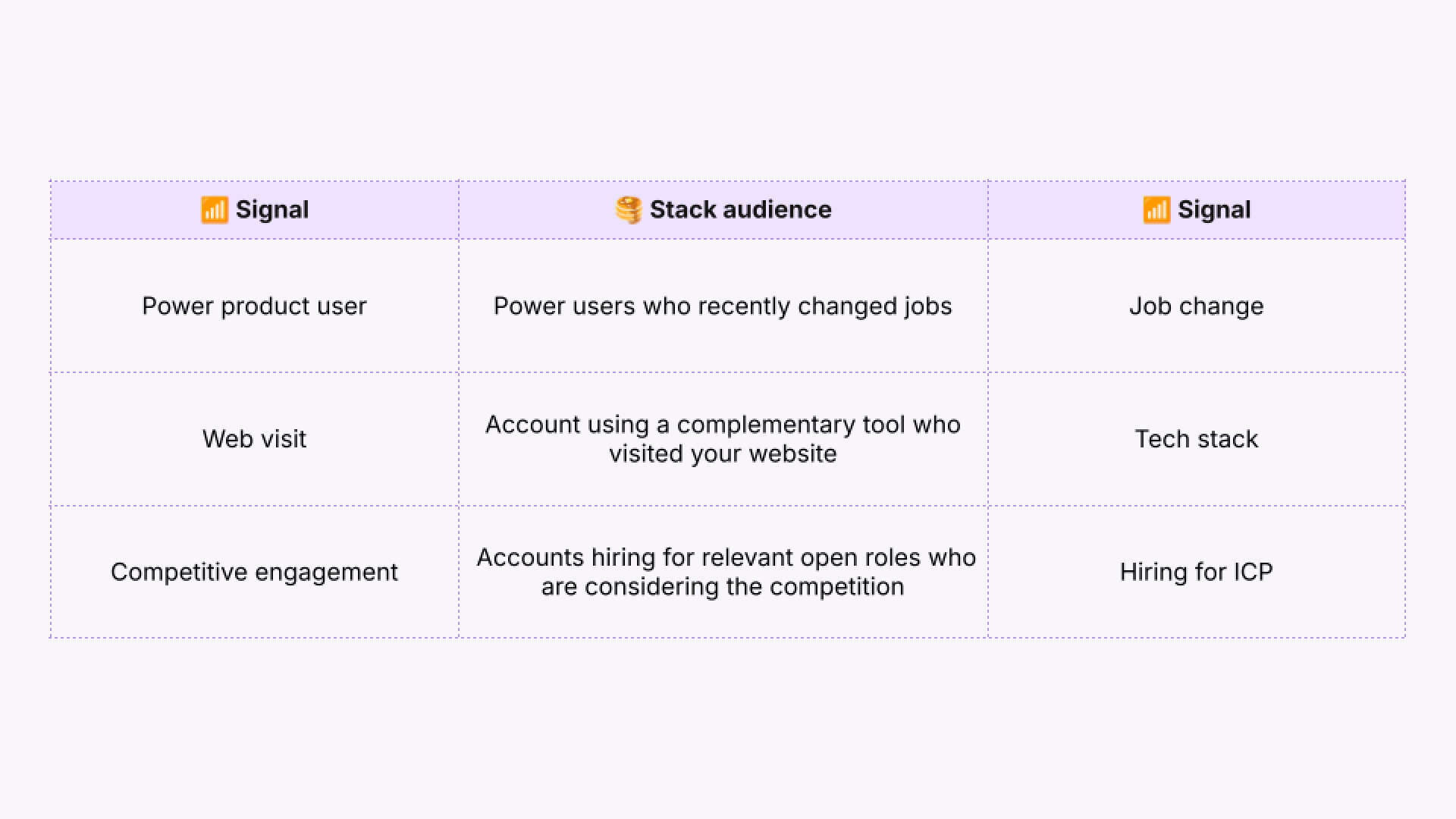
Power user plus job change
Say we’ve been running signal-based plays focused on product power users. We’re confident we’ve maximized the potential of focusing on product usage alone. Now we’ll stack another signal on top to create a new play.
In this case we’ll focus on job changes. By combining an employment-based signal with a product-based signal, we’re opening the door to a more targeted play: former power users who recently switched organizations.
This helps us prioritize these buyers (job-change signals have a built-in shelf life and new hires tend to spend their tooling budgets fairly quickly) and personalize our message.
We’re not just reaching out to a product champion. We’re reaching out to a product champion who recently took on a new role and may be looking to add a tool like ours to their stack.
Website visit plus tech stack
Say we were previously running signal-based plays built around website activity (think something like pricing page visits). By combining that signal with a tech stack signal—as in, the prospect is using a tool that either complements or competes with ours—we get more intelligence we can use to prioritize website visitors and craft more compelling messaging.
We’re not just offering to walk a web visitor through our different plan options. We’re also telling them how existing customers drive better results by combining our product with another tool or ripping and replacing it completely.
LinkedIn engagement plus hiring trend
Say we’re running signal-based plays using social signals. In this case, we’re outbounding high-fit prospects who are engaging with our competitors on LinkedIn.
Well, by combining another employment-based signal—job postings, in this case—we can get even more targeted in our prioritization and messaging.
We’re not just talking about how we compare to a competitor, we’re talking about how we can help a prospect who’s looking to hire someone that matches our ideal user persona.
In each example above, the pool of potential prospects may get smaller than when using one signal alone, but signal stacking opens the door to more granular (and therefore more effective) targeting and messaging.
Get familiar with signal stacking dos and don’ts
When it comes to signal stacking, it’s worth keeping a few best practices in mind:
Do: Expand your signal palette
There are lots of signals you may not currently be tracking. While not every signal will be a game changer for you, optionality is key.
If you’re unable to test out different plays built around different types of signals, you’ll never know what works best for your growth stage or GTM motion.
Try not to limit yourself or over-index on only a handful of obvious signals. Experimentation is key to discovering your top performers and building hyper-specific plays.
Don’t: Treat all signals the same
Not every buying signal is worth your time.
In fact, in some cases, they simply won’t make sense. For example, if you don't have a product-led GTM motion, product usage signals won’t do you much good.
Signal volume and strength will differ across growth stages (like startups with limited first-party data versus enterprises with mountains of owned data) and GTM motions (like commercial open-source software versus top-down SaaS).
Do: Explore signal-based scoring
Signal stacking helps with prioritization. Signal-based scoring automates it.
By creating a scoring model based on buying signals, you can speed up the prioritization process at scale.
The key is making sure you have full context for why a score is assigned (that is, which signals a prospect matches). Black box scores won’t help you craft relevant messaging.
Don’t: Forget about fit
Buying signals aren’t actionable without firmographic fit.
Someone might be showing intent, but if they’re not a match for your ideal customer profile or in a position to buy, it can send you on a wild goose chase.
Fit is especially important for third-party signals that may not show intent, but indicate an org is in market (think things like relevant job listings and news stories).
Do: Add more signal to your signals
Volume of signal helps separate good prospects from great ones.
Say someone from an ICP-match company signs up for a free trial. Or maybe one of your target accounts posts a relevant job listing.
Now imagine multiple people from that company sign up to use your product. Or that target account posts dozens of relevant job listings. More signal means more opportunity.
Don’t: Lose sight of actionability
The more signals you have, the more room you have to create differentiated signal-based plays that can yield higher returns.
But it’s not just about the signals you uncover—it’s about how you execute against them.
Bouncing between data silos to extract insights kills efficiency. It’s crucial to help reps get full visibility into signals and action on them quickly.
Common Room makes signal stacking a piece of cake
Signal stacking requires access to buying signals and the ability to action on them fast.
Enter Common Room.
Digital signal capture
Capture all first-, second-, and third-party signals from every data source automatically using our AI-powered platform’s natively built and fully managed integrations. Product usage, website visits, CRM records, social engagements, open-source activities, community interactions—it’s all yours for the taking.
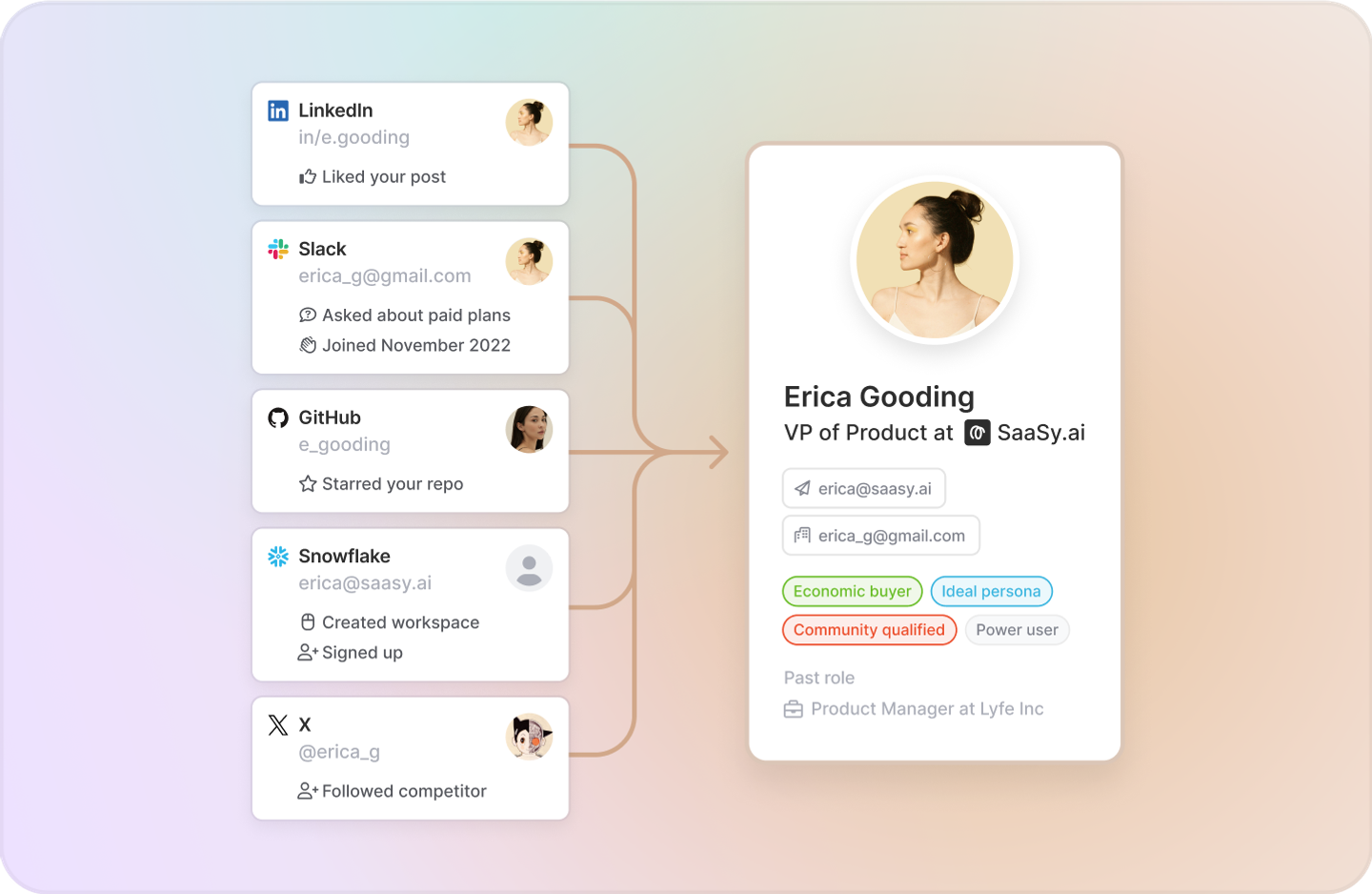
Unified identity and account intelligence
Let our AI-powered identity resolution and waterfall enrichment engine, Person360™, automatically deanonymize, enrich, and unify each signal into a complete profile for all contacts and accounts. Get a 360-degree view of every prospect’s and company’s actions and attributes for qualification and prioritization.
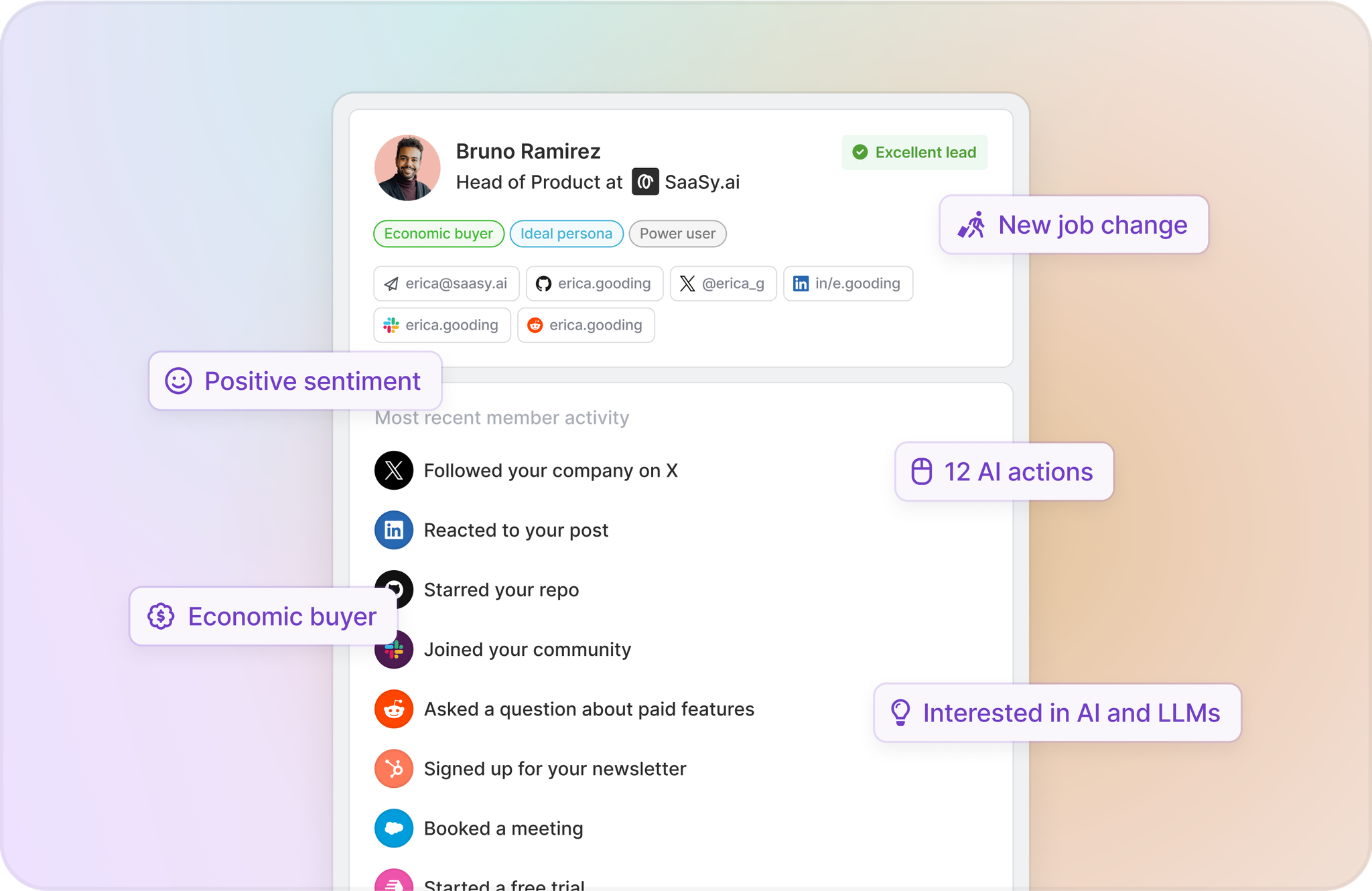
Actions and automation
Stay updated on all activity in real time, segment contacts and accounts into auto-replenishing burndown lists automatically, generate personalized, relevant outreach with the help of AI, add contacts to bespoke outreach sequences in your tool of choice, or automate the outbound process from end to end using custom workflows.
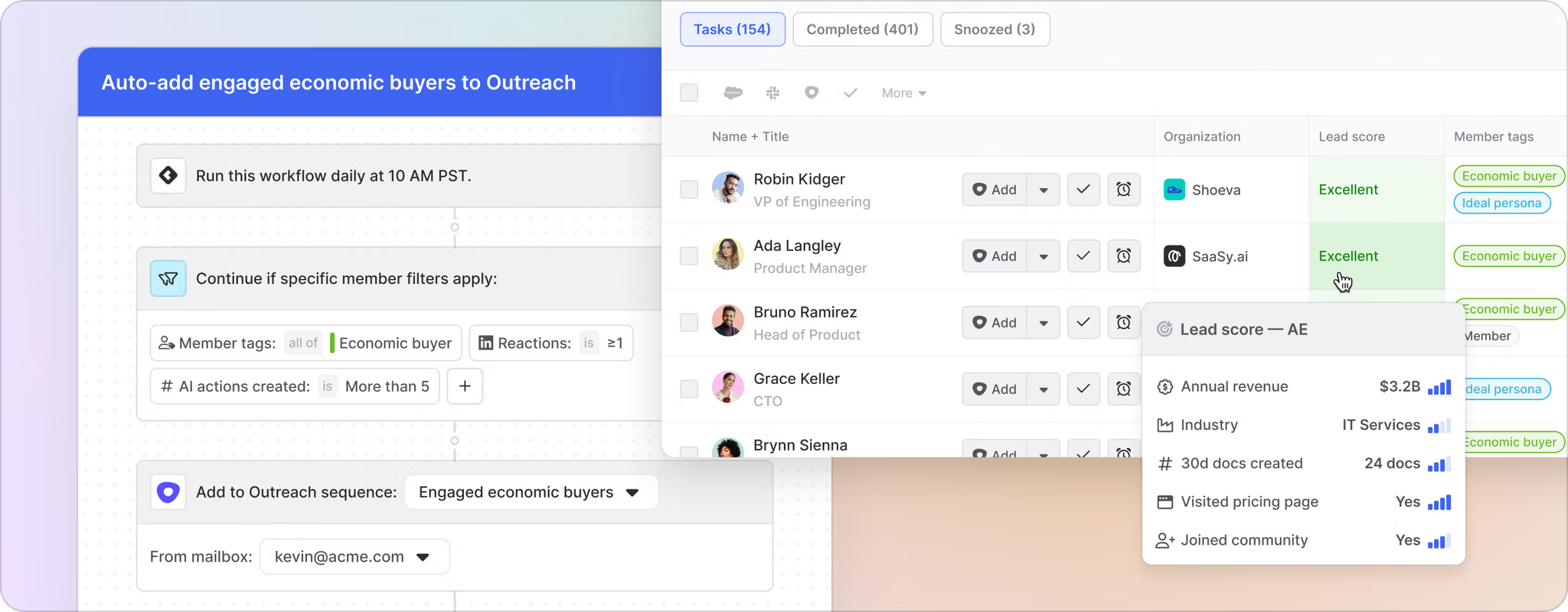
You can try it for free today.
Want a refresher on all things signal-based selling? Check out the first and second editions of Signal school here and here.
Stack buying signals instead of tools with Common Room
Get started for free or get in touch to see how Common Room can help you find and follow up on every buying signal fast.
